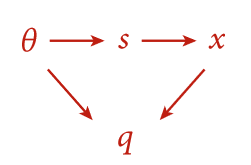INFO
🎉 This review presents a framework for modeling imperfect causal reasoning in decisionmaking contexts. The model uses directed acyclic graph (DAG).
Summary
A Toy example
A seller sells the product with quantity
The seller chooses
: given the signal, what is the underlying demand : the price effect of on , given - It is a Causality question.
A Graphical Structure

Why do Standard Analysis do not consider the Casality
Three assumptions about the whole reasoning process:
- DM (decision-maker) reason in terms of a correctly specified model
- the conditioning procedure (i.e. prior to posterior) follows rational patterns like Bayesian for the causal interpretation of probabilistic information
- DM knows the prior joint distribution over all relevant variables—i.e., there are no hidden variables
Four Questions when the assumptions are not satisfied
- Does the decision maker (DM) interpret empirical regularities in his environment through the prism of a subjective causal model?
- Is this model correctly specified?
- Do the observational data at the DM’s disposal enable the quantification of causal effects (especially the effect of his own actions on payoff-relevant consequences)?
- Which methods for drawing such causal inferences does the DM employ?
An Example: The Dieter's Dilemma
Settings
Healthcare problem. The DM decide to buy a drugs at a cost
A rational DM would not buy the drugs since it not works but costs.
Misperceived Causality Suppose the decision
That is, the consumer’s health level is abnormal
We assume there are some historical realizatiton of the decision, which forms the prior distribution:
The DM believes there is an underlying causal structure
That is, the drug buying decision affect the blood pressure and then affect the health. The form a quantitative belief based on the history information, he measure the conditional probability
If the causal model is correct, it is correct to write down
Reversed causality
The true causality is:
where the causality link between
DM Behavior.
The DM determines
The
whereas we find
We can write
Equilibrium.
Define it as a personal equilibrium if the action strategy
This notion of equilibrium captures a steady state in the population of ex-ante identical consumers who face the same dieter’s dilemma.
we calculate:
and
when
Error.
The consumer’s reverse causality error leads him to take the suboptimal action of consuming a useless product with positive probability. Remember the rational choice is not to take the product.